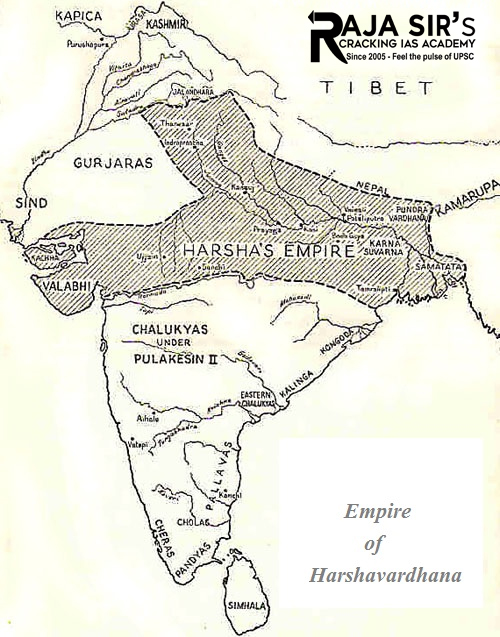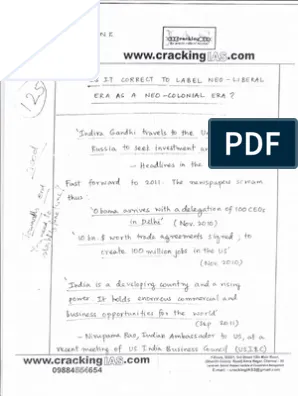- Home
- Prelims
- Mains
- Current Affairs
- Study Materials
- Test Series
 EDITORIALS & ARTICLES
EDITORIALS & ARTICLES
Post-Gupta Era
The successive invasion of Hunas from Central Asia made the Guptas very weak and thus affected the economy. It is indicated by the gold coins of later Gupta rulers, which have less gold content and more alloy.
- The decline of the Gupta empire resulted in the emergence of numerous ruling dynasties in different parts of northern India.
- The prominent among them were the Pushyabhutis of Thanesar, the Maukharies of Kanauj, and the Maitrakas of Valabhi.
- The political scene in Peninsular India was no different.
- The Chalukyas and the Pallavas emerged as strong regional powers in Deccan and northern Tamil Nadu, respectively.
What factors led to the fall of the Guptas?
The prominent factors which led to the fall of the Guptas can be summarised below:
- Invasion of Hunas from Central Asia: The successors of Skandagupta proved to be weak and could not cope with the Hunas, who were strong horsemen.
- Rise of feudatories: The governors and their feudatories appointed by the Guptas in the Bengal region tended to become independent.
- The decline in foreign trade: After Skandagupta, hardly any Gupta coin or inscription has been found in western Malwa and Saurashtra.
- The loss of western India deprived the Guptas of the rich revenues from sea trade and commerce and crippled them economically.
- Land grants: Because of the growing practice of land grants for religious and other purposes, it was difficult for Guptas to maintain a large army. It was bound to reduce their revenues.
|
Vakataka Dynasty - Rulers and their Contributions |
|
|
Period: 250-510 AD |
Capital: Vatsagulma (modern Washim) |
|
|
|
Vindhyashakti (250-270 AD) |
|
|
Pravarasena I (270-330 AD) |
|
|
Prabhavatigupta (385-405 AD) |
|
|
Maitrakas - Rulers and their Contributions |
|
|
Period: 475-776 AD |
Capital: Valabhi |
|
|
|
Pushyabhutis of Thanesar - Rulers and their Contributions |
|
|
Period: 500-647 AD |
Capital: Thanesar (Thaneshwara), later Kannauj (Kanyakubja) |
|
|
|
Harshavardhana (606-647 AD) |
|
|
|
|
Contributions to Art and Architecture |
|
|
|
|
Sultanganj Buddha (500-700 AD) |
|
|
Other Arts |
|
|
Contribution to Literature |
|
|
Harshavardhana |
|
|
Banabhata |
|
|
Jayasena |
|
|
Mayurabhatta |
|
|
Hsuen Tsang |
|
|
Contemporary Scholars |
|
Administration under Harshavardhana
- On the same lines as Guptas: Except that his administration had become more feudal and decentralised.
- Land grants: Continued to be made to priests for special services rendered to the state.
- In addition, Harsha is credited with the grant of land to the officers by charters.
- Law and Order: It was not well maintained. Hsuen Tsang, about whom special care may have been taken, was robbed of his belongings.
- Empire division: Provinces (Bhuktis), provinces into districts (Visayas), and the districts into villages (gram).
- Officers: Same as under Guptas.
- The high officials such as Mahasamantas and Maharajas were hereditary- local chiefs.
- Othe provincial officers were Kumaramatyas, Uparikas, etc.
- Visayapati was the district officer, and Gramika was the village officer.
- Karanikas: The central and provincial governments maintained a keeper of records called Karanika.
Society and Religion under Harshavardhana
- Sources: Both Banabhata and Hsuen Tsang portray the social life in the times of Harsha.
- Prevalent fourfold division:
- The Brahmins were the privileged section of the society and were given land grants by the kings (Brahmadeya grants).
- The Kshatriyas were the ruling class.
- The Vysyas were mainly traders.
- Hiuen Tsang mentions that the Sudras practised agriculture.
- There existed many sub-castes.
- The position of women: It was not satisfactory.
- Remarriage of widows was not permitted, particularly among the higher castes.
- The system of dowry was also common.
- The practice of sati was also prevalent.
- Religious policy: Harsha followed a tolerant religious policy.
- A Shaiva, in his early years, gradually became a great patron of Buddhism under the influence of Hsuen Tsang.
- Buddhism under Harsha: As a devout Buddhist, he convened a grand assembly at Kannauj to widely publicise the doctrine of Mahayana.
Economy under Harshavardhana
- Trade and commerce: Declined during Harsha''s period. This is evident from the decline of trade centres, less number of coins, and the slow activities of merchant guilds.
- Effect on industry: The decline of trade, in turn, affected the handicraft industry and agriculture.
- The farmers began to produce only in a limited way due to less demand. This led to the rise of the self-sufficient village economy.
- Taxes: The royal revenue was derived from three kinds of taxes, namely the Bhaga (Share), Bali, and Hiranya.
- Bhaga: The major source of revenue was the Bhaga (land tax). Bhaga was the one-sixth share of the produce of the land taken as revenue.
- Other taxes: There were ferry tax, customs duty, etc.
|
Maukharis - Rulers and their Contributions |
|
|
Period: 510-606 AD |
Capital: Kannauj (Kanyakubja) |
|
|
|
Pallavas of Kanchi - Rulers and their Contributions |
|
|
Period: 575-897 AD |
Capital: Kanchi |
|
|
|
Chalukyas of Badami - Rulers and their Contributions |
|
|
Period: 543-755 AD |
Capital: Badami |
|
|

Administration in Post-Gupta Period
- Administration: It was mostly centralised.
- The administration under Harsha was more feudal.
- Titles of officials: Continued as in the Gupta period. A class of officials was known as Kumaramatyas.
- The Samanta: Semi-independent local chiefs of this period.
- Land grants: Continued to be made to priests for special services rendered to the state.
- Judicial system: More developed than Guptas. Legal matters were dealt with by Dharmashastras. There was a differentiation between civil and criminal cases.
Society and Religion in Post-Gupta Period
- Emergence of new castes: As trade declined, with the transformation of guilds, new castes emerged.
- Growth of Kayasthas: As land grants grew, there was a need for a body of scribes and record keepers who were employed to draft assignments of land and keep details of land transfer, including various items of revenue. Thus Kayasthas emerged.
- Social status: Due to the position of land holding and association with agriculture, the position of Shudras improved, and that of Vaishyas decreased.
- Position of women: There was a progressive decline. Early marriages were preferred.
- Religious policy: The post-Gupta dynasties followed tolerant religious policies.
- Religion: The orthodox Brahmanical order continued to be challenged, particularly by movements within Shaivism, by poet-saints, and by those who practised the Tantric form of worship.
- Most religions, irrespective of whether it was Brahmanism, Buddhism, or Shaivism, developed institutional bases in the form of temples and monasteries.
- Ruling powers supported institutions and Brahmanas, monks, and Acharyas by grants of land, wealth, and other means. Through these acts of patronage, the ruling powers strengthened their social base.
- Emergence of the Bhakti movement was a special feature of this period.
Economy in Post-Gupta Period
- Trade and Commerce: Northwestern route disruption by Hunas resulted in a comparative decline in the country’s trade and commerce.
- Till 550 AD, India continued to have some trade with the eastern Roman Empire, to which it exported silk and spices.
- Loss of gold: The loss in trade lessened the inflow of gold and silver into the country. It is confirmed by a general scarcity of gold coins after the Guptas.
- Self-Sufficient economy: Thus, in the absence of coinage, we can presume that a self-sufficient economic system with limited trade prevailed after the downfall of the Guptas.
- Feudal land tenure: Yajnavalkya and Brihaspati, authors of Smriti''s works, mention four grades of land rights in the same piece of land. It led to hierarchical rights over land and sub-infeudation.
- The Mahipati (king),
- Kshetrasvamin (master of the land),
- Karshaka (cultivator) and
- The sub-tenant.









 Latest News
Latest News General Studies
General Studies